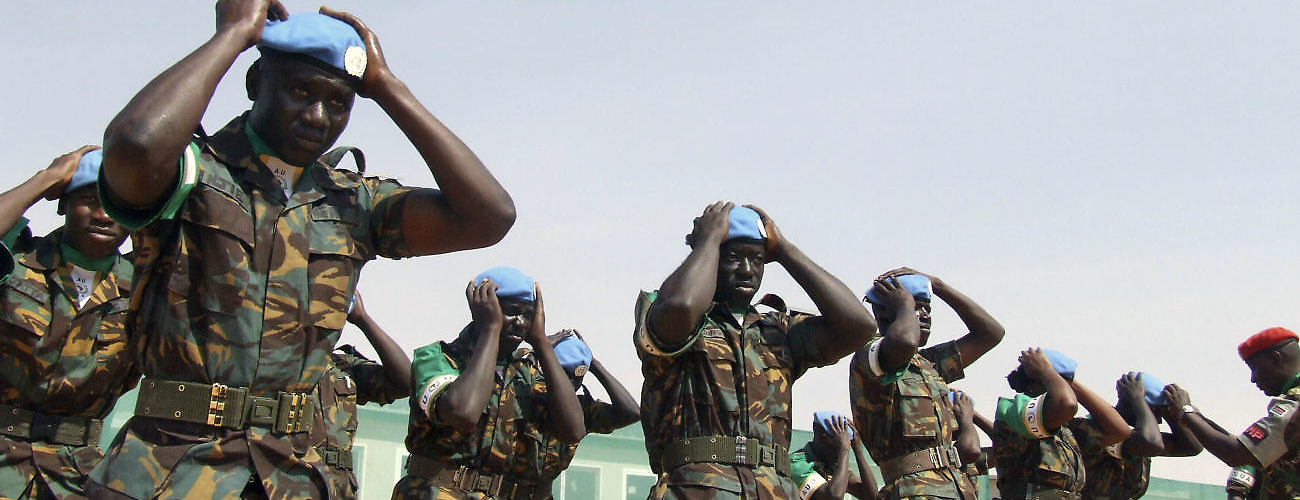Former military personnel of the African Union Mission in Sudan (AMIS) put on the traditional blue beret marking the transition of authority to the UN Mission in Darfur (UNAMID) in 2007, in accordance with resolution 1769. (UN Photo/Shereen Zorba)
Almost thirteen years ago, the United Nations Security Council adopted resolution 1769 mandating the deployment of a joint UN and African Union force (UNAMID) in Darfur. I was the diplomat at the United Kingdom’s Mission to the UN in New York who was tasked with writing, and chairing the Security Council negotiations on, the resolution. As the UN and AU start to look towards transitioning from peacekeeping to peacebuilding in Darfur, what lessons are there—for Sudan, UN peacekeeping, and addressing future humanitarian crises—from the adoption of resolution 1769? Here are five.
First, getting international agreement to deploy UNAMID took a long time to secure. The conflict in Darfur had raged for years. A smaller African Union (AU) force (AMIS) was operating but its ability to protect civilians was impacted by limited resources and a reliance on voluntary funding. The administration in the United States at the time under President George W. Bush had looked at options for direct US military engagement—including a no-fly zone—but concluded, in the aftermath of the Iraq War, that the UN was best placed to take the international lead. The conclusion of the Darfur Peace Agreement (DPA) provided a hook for a UN peacekeeping force to be deployed by creating a peace for the UN to keep. The long process of deploying UNAMID should serve as a note of caution as preparations are made for a transition in Darfur, particularly given political dynamics in Khartoum and divisions in the Security Council.
Second, resolution 1769 was a big deal for Darfur because it saved lives, but it was also significant for the UN as an institution. UNAMID was the world’s largest peacekeeping force and the first time the UN had launched a joint/hybrid force with the AU. It was an innovative experiment in how to do peacekeeping and in cooperation between the two organizations. The UN’s reputation was on the line. Building on the successes of UNAMID and the boost it gave to the UN will go far in helping the UN to address other humanitarian crises.
Third, the original plan had been for a UN-only force, but Sudan would not accept this. Earlier in 2006, the Security Council adopted a US-drafted resolution mandating the deployment of a UN force in Darfur (UNMID). Some Council members were concerned about the US putting its draft text to the vote before Sudan had given its consent, because a UN peacekeeping force required the agreement of the host country to deploy. The US ambassador at the time, John Bolton, calculated that the Council mandating the operation would force Sudan to change its position. It didn’t. China, Russia, and Qatar also abstained in the Council vote. UNMID was a historic blow to the authority of the Security Council. It was the first time a UN peacekeeping force it had mandated was rejected by a UN member. Given the current political dynamics in the Security Council, ensuring broad support for peacekeeping missions and peacebuilding should be seen as an important prerequisite.
Fourth, the idea of a joint UN-AU force was a piece of smart diplomatic dexterity to break the stand-off between the Council and Sudan. It got traction because different parties interpreted it differently. The joint force was presented to the Sudanese as a continuation of the AU force just with additional UN funding and support. In contrast, Western countries saw UNAMID as primarily a UN force that would be co-badged with the AU to make it acceptable to the Sudanese. These different interpretations enabled the force to be negotiated and agreed upon. But they also sowed the seeds for tensions later when it was being deployed. The need for clever diplomatic solutions is an important lesson for navigating political impasses.
Fifth, securing Sudanese support for UNAMID wasn’t easy. Sudan was eventually brought on board through a mixture of coaxing and coercion. The threat of sanctions was particularly important. The US, UK, and France (P3) were clear with Khartoum that if it rejected a UN/AU joint force it would be choosing a path of confrontation with the Council, and UN sanctions could follow. This warning also impacted Sudan’s allies on the Council. They were concerned that if Washington proposed sanctions, they would face an unpalatable choice of either letting them pass, impacting their equities with Sudan, or blocking them, impacting their international reputation and relations with the US. A Sudanese agreement to accept a UN/AU mission sidestepped this choice. Sudan’s allies played an important role in pressing Khartoum to evolve its position and accept the force.
The adoption of resolution 1769 was a success for the Security Council, the AU, and the UN. It was the result of both geopolitical dynamics (the US-China relationship being particularly important) and creative diplomacy around the Security Council table. UNAMID wasn’t, and isn’t, perfect. But a good peacekeeping mission was mandated that saved lives and met the red lines of the various players on Council, as well as of the AU and Sudan. It was an example of diplomacy working and of the Security Council coming together to address a humanitarian crisis. The contrast with the Council’s performance on Syria thirteen years later is a stark reminder of what is stake when diplomacy doesn’t work.
David Whineray is a senior fellow at the University of California, Berkeley, a fellow at the Carnegie Endowment for International Peace in Washington, D.C., a visiting assistant professor at New York University and a visiting scholar at Columbia University in New York.





